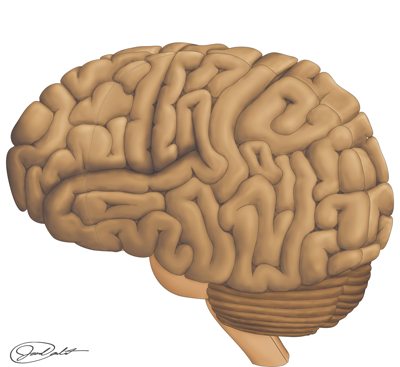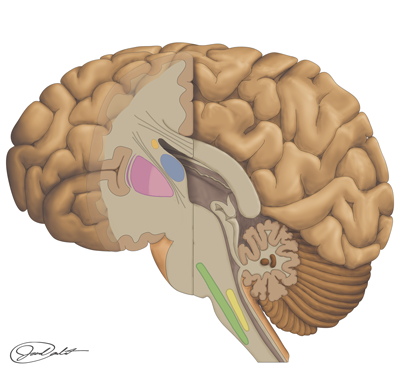THE BRAIN
INTRODUCTION / REGIONS OF THE BRAIN
 |
 |
Image created by BYU-I student Jared Cardinet S15
Introduction
The human brain is an incredible organ. In a Scientific American article published Oct 12, 2011, Mark Fischetti compared the human brain to the largest super computers. In the article he states: "For decades computer scientists have strived to build machines that can calculate faster than the human brain and store more information. The contraptions have won. The world's most powerful supercomputer, the K from Fujitsu, computes four times faster and holds 10 times as much data. And of course, many more bits are coursing through the Internet at any moment. Yet the Internet's servers worldwide would fill a small city, and the K sucks up enough electricity to power 10,000 homes. The incredibly efficient brain consumes less juice than a dim lightbulb and fits nicely inside our head." The brain is the center of the nervous system and its functions include receiving, evaluating and responding to sensory input, storing information, planning future activities, reasoning and abstract thought. These functions are carried about by neurons, over 100 billion, which use action potentials as a means of communicating to other parts of the brain or to the rest of body. In order to generate the large number or neurons, our fetal brains had to produce about 500,000 neurons per minute during the early days of development. Each of us has about the same number of neurons in adulthood as they did at birth but the neurons grew and reached a maximum size at about age six. Synapses and brain organization continue through age 20 and perhaps beyond. How neurons send and receive action potential signals is well understood, but the way that neurons give rise to conscious awareness is still a mystery. It appears that a thought is a physical pathway of neurons in the brain. The more you use that pathway the easier it becomes to use, this is why repetition is so important in learning. This is also why having the thought "I'm so ugly," or "I'm a bad test taker" is never a good idea. Amazingly, aside from brain disease, your brain never loses the ability to learn and change. It is an urban legend that you only use 10% of the brain, we use it all!
As we study the brain we will identify different structures that are involved in specific functions. However, it is good to keep in mind that typically a given function will involve more than one region of the brain and that each region is probably involved in more one function at a time. A good example is muscle movement. Normal, coordinated muscle movement involves several regions in the frontal lobe of the cerebrum, the basal nuclei and the cerebellum. We will see many other examples of this as we study the brain.
Regions of the Brain
Although in appearance the human brain is nothing more than an oversized wrinkled walnut with the consistency of damp oatmeal, it can be divided into four major regions: the cerebrum , the diencephalon , the brain stem, and the cerebellum (see figure below). Additionally, each of these regions can be further subdivided into multiple structures. We will be learning the basic functions of each of these regions.

© 2013 Encyclopædia Britannica, Inc. Downloaded from Image Quest Britannica; BYU-Idaho.
Diagrams, moving from left to right, illustrating the cerebrum, the diencephalon, the brain stem, and the cerebellum.
**You may use the buttons below to go to the next or previous reading in this Module**

